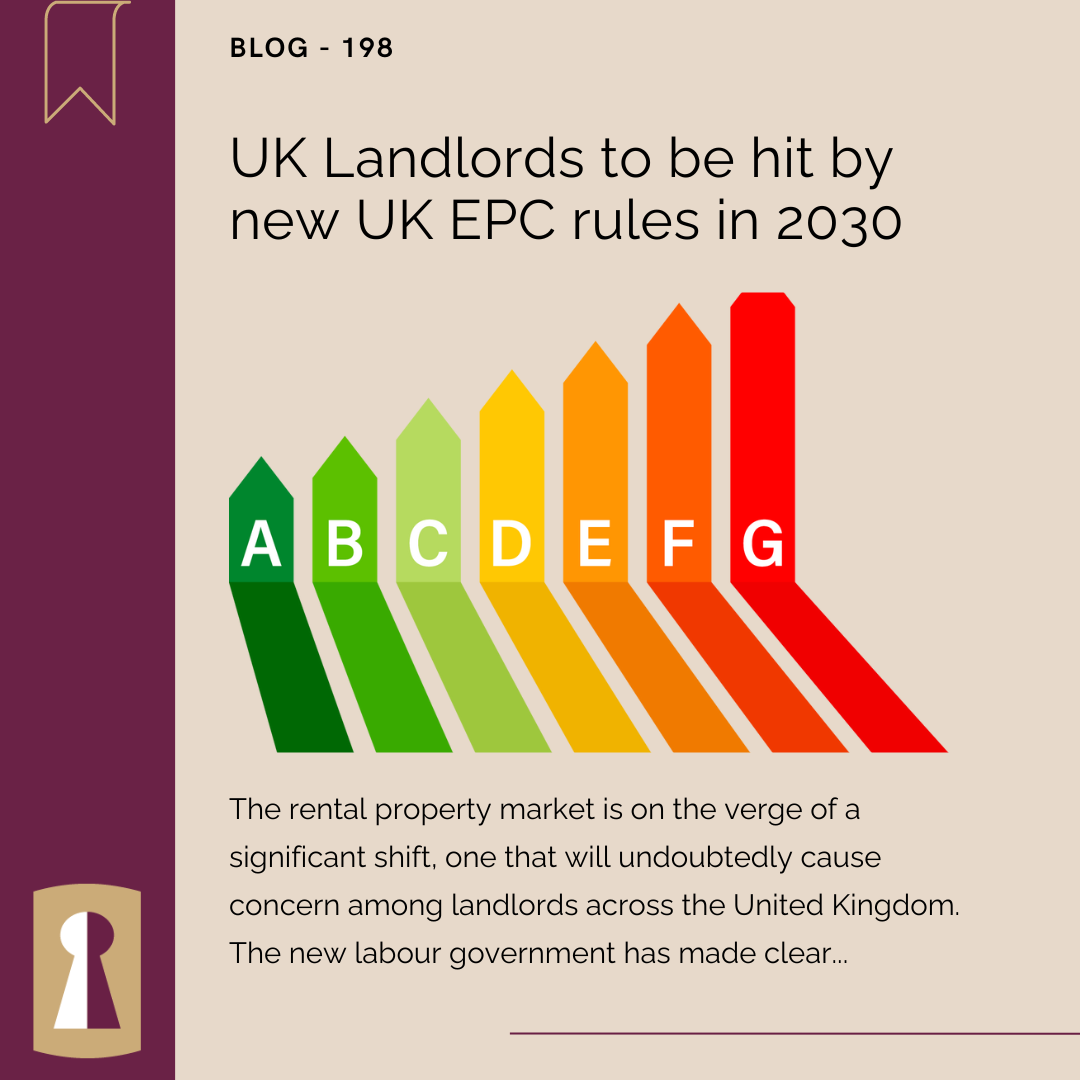The rental property market is on the verge of a significant shift, one that will undoubtedly cause concern among landlords across the United Kingdom. The new labour government has made clear its intention to raise the minimum energy performance standards for rental properties, a move that could have far-reaching implications for both landlords and tenants alike.
The proposed change would see the minimum Energy Performance Certificate (EPC) increase from E to C by 2023 and has sparked a mix of uncertainty and anxiety within the rental property sector.
The new regulations are a part of Labour’s wider commitment to combat climate change and enhance the energy efficiency of the UK’s rental homes. This is also a bid to reduce tenant bills given the current energy crisis and cost of living crisis.
The previous conservative government introduced EPC regulations for private rental properties in 2018. This was a part of the broader effort of the previous government to improve the Energy Performance of the UK’s housing stock. Under these regulations, landlords were required to make sure their properties met this minimum standard EPC rating of E, before they were allowed to be placed on the rental market. To support landlords in doing this, exemptions were allowed, and a cost cap was introduced to limit the amount landlords were required to spend on their properties to improve their EPC.
This cap was implemented to reduce the strain on landlords financially, particualry those with older properties. The £3,500 cap covered a range of potential improvements, including insulation, heating system upgrades, and draught-proofing, and was seen as a balanced approach that allowed landlords to comply with the new standards without facing prohibitive costs.
THE SCALE OF THE CHALLENGE FOR BATH LANDLORDS:
The implications of these changes are likely to be profound. Some Bath landlords may decide that the cost of upgrading is simply too high and choose to sell their Bath properties instead. This exodus from the rental sector could exacerbate the current shortage of housing for tenants and hence drive up rents, and make it even more difficult for tenants to find affordable rental homes.
There is also the risk that the increased financial burden on landlords would be passed onto the the tentants in the form of higher rent increases. While the goal of improving the EPC of these homes is to reduce the overall living costs of tenants by lowering their energy bills, this benefit could be offset by the landlords raising their rents to recoup the associated costs.
DOES AGE, TENURE AND TYPE OF HOME MAKE A DIFFERENCE TO THE EPC RATING?:
The EPC scores associated with each band are as follows:
- Band A – 92 plus (most efficient)
- Band B – 81 to 91
- Band C – 69 to 80
- Band D – 55 to 68
- Band E – 39 to 54
- Band F – 21 to 38
- Band G – 1 to 20 (least efficient)
Looking at only the property type, it certainly affects energy efficiency. Overall, flats and maisonettes are the most ‘energy-efficient’ property type in the UK with a median efficiency score of 73, so a Band C EPC. Detached and terraced properties came in second with a median score of 66 equating to a Band D EPC, and finally in last place was semi-detached houses with a median score of 65, so also a Band D.
Detached homes tend to be more modern and as such, should be expected to have a higher energy rating. There are three external walls exposed in semi-detached houses, which would make you think they would have an overall better average EPC. However, the average age of UK semi-detached homes is older than detached homes and this is where efficiency is lost.
Finally, the terraced home normally only has two external walls, so should be better than semis and detached homes. Yet, terraced homes have solid walls, which make them perform not as well as cavity walls. Finally, flats and maisonettes, are more likely to be more modern and grouped in blocks, making them more efficient.
Breaking down each type into its three tenures of owner-occupiers, private renting and social renting…
Detached properties exhibit relatively similar energy efficiency ratings across all tenures, with owner-occupied homes scoring an average of 64, slightly higher than the private rented sector at 62, with social rented properties at 66. This suggests that while there is a marginal variation, socially rented detached homes tend to be more energy efficient on average.
Semi-detached homes show uniformity in energy efficiency for owner-occupied and private rented properties, both with an average rating of 63. Social rented semi-detached homes, however, are somewhat more efficient, with an average rating of 68. This may reflect better insulation or energy-saving measures in the social housing sector.
Terraced properties reveal a small increase in energy efficiency as we move from owner-occupied (63) to private rented (64) and then to social rented (69). This trend indicates that terraced homes in the social rented sector might benefit from recent energy efficiency upgrades or more rigorous building standards.
Finally, flats and maisonettes demonstrate the highest energy efficiency ratings across all property types, with owner-occupied and socially rented homes both scoring 72, and privately rented properties closely following at 70. The higher ratings in this category could be due to the structural benefits of multi-unit buildings, such as shared walls that reduce heat loss.
In summary, while there are differences in energy efficiency across different property types and tenures, social rented properties generally exhibit higher energy efficiency ratings, particularly in the semi-detached and terraced categories. This may reflect concerted efforts within the social housing sector to improve energy efficiency, possibly driven by policy initiatives and funding targeted at reducing fuel poverty.
AGE:
Finally, let us look at the age of properties and if there is any correlation between age and energy performance rating.
The age of a home is a key determinant of its energy efficiency, largely due to advancements in construction techniques and building regulations over time. Properties built from 2012 onwards tend to have the highest EPC ratings, with a median score of 84 (Band B). Homes constructed between 1983 and 2011 also perform relatively well, with a median score of 72 (Band C).
Moving on to older properties – looking particularly at those built between 1930 and 1982, these have a lower median energy performance rating of 65, equating to an EPC rating of Band D. The least efficient homes are those built pre-1930 which have a median score of 59, ranking them with an average EPC of Band D also.
THE LOCAL BATH PICTURE:
38.36% of the UK privately rented homes are in the proposed minimum EPC standards of A to C. Locally in the South-West, there was an average of 40.63% of homes falling between those marks.
Nationally, 59.46% of private rented homes are in the D and E bands of the EPC rating system and locally again in the south-west, there are 56.46% of private rented homes in this category.

In other words, over 50% of privately rented properties in Bath are within the EPC bands D to E which would mean under these proposed changes they would need to be improved. To visualise this better, there is a heat map below of the homes that would fail the testing under the proposed new law.

BATH LANDLORDS NAVIGATING THE UPCOMING UNCERTAINTY:
In the face of this wave of new challenges, landlords in Bath must adopt a pragmatic approach. While the initial reaction may be one of concern, it is important to consider the long-term benefits of making these energy improvements to your investment properties. Properties with higher EPC ratings are more attractive to tenants, alongside this they also tend to yield higher market value. By investing in upgrades to your investment property, you can not only comply with the new regulations afoot but also enhance the value of your property on the market.
Moreover, there may be an opportunity to mitigate the costs. The government has yet to finalise the details of the new regulations and there is hope that they will introduce measures to support landlords through this transition to more energy-efficient homes. There may be grants, loans or tax incentives available to those who make the improvements and thus offset some of the cost.
Bath landlords should also consider the timing of their investments. While 2030 may seem distant, the scale of work required means starting early could be beneficial. Properties that are upgraded sooner rather than later will be in a better position to attract and retain tenants, particularly as energy efficiency becomes an increasingly important consideration for renters. Furthermore, by acting now, landlords can avoid the rush and potential price increases that are likely to occur as the deadline approaches.
It is also worth considering the broader societal benefits of these changes. Improving the energy efficiency of rental properties is not just about meeting government regulations; it is about contributing to the fight against climate change and helping to reduce the country’s overall carbon footprint. This is something that both Bath landlords and tenants can take pride in, and it aligns with the growing demand for more sustainable living options.
Again, the improvements made to properties will not only benefit current Bath tenants but also increase the long-term viability of the rental market. As properties become more energy-efficient, they will be better equipped to withstand future changes in energy prices and regulations. This future-proofs investments and ensures that landlords can continue to offer quality housing in a competitive market.
FINAL THOUGHTS: A STRATEGIC APPROACH FOR BATH LANDLORDS:
In conclusion, while the proposed changes to EPC requirements may initially seem daunting, they should be viewed as an opportunity rather than a threat. By taking a proactive and strategic approach, Bath landlords can not only meet the new standards but also enhance the value and appeal of their properties. This will not only benefit their portfolios but also contribute to a more sustainable and resilient local rental market.
The key is to start planning now, seek out advice from Letting and Estate Agents such as ourselves or many of the other agents located in Bath, and consider the long-term benefits of these changes. The road ahead may be challenging, but with careful planning and a commitment to improving the quality of rental housing, Bath landlords can navigate this transition successfully.
As leaders in the local property market, feel free to contact us to discuss what has been said in the article as it is everyone’s responsibility to not only meet these new standards but to embrace the positive changes they bring.

